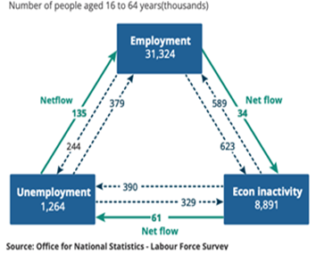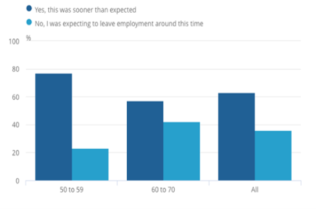Labour Market Update – November 2022

In an ever changing labour market, it’s important for us to consider any key trends and data to help support recruitment and employee engagement strategies.
The new DWP Secretary of State, Mel Stride who is the MP for Central Devon, spoke in the House of Commons on 25th October 2022 saying there are “2.5 million people who were ‘long term sick’ and ‘economically inactive’ but wanted a job”. These figures are a bit misleading as according to recent ONS statistics, only 581,000 of this group want a job.
It was reported by the Disability News Service that Mel Stride had described this group – most of whom will be disabled – as “a long tail of people”. He said there was a “need to push more people who were currently economically inactive into the workforce, stating a ”desperate need” to do this. This gives us an indication of the DWP’s direction of travel.
The latest ONS Labour Market Overview reported:

According to the latest ONS data, there are 2.5 million people out of the labour force because of long term sickness, half a million more than in 2019. This increase started before coronavirus, but since early 2020 has risen by 363,000. 28% of those classified as economically inactive give the reason as long-term sickness, up 3% since pre-pandemic.
ONS Over 50s Lifestyle Study (OLS) gathers information from the over 50s to better understand their motivations for leaving work and whether they intend to return to work. There have been 386,096 more economically inactive adults aged 50 to 64 years than before the pandemic.
In the August 2022 survey, people aged 50 to 59 said:
Leaving work earlier than expected was higher among adults in their 50s than those aged 60 and over.

Labour market analysis from the Recruitment and Employment Confederation (REC) revealed 217,000 new job postings in the week 10-17 October and a dip 17-23 October with 154,000 ads posted – 3.4 per cent lower than a month earlier.
The Grocer reported on evidence given at The Environment, Food and Rural Affairs Committee’s Inquiry into Food Security that “the UK’s self-sufficency is contracting rapidly due to unprecedented financial and labour based challenges faced by producers, with production dropping to record lows in some sectors.”
The Food and Drink Federation (FDF) has published its State of Industry Report Q3 2022. It found that industry confidence has continued to fall and is the lowest since records began in 2018. The outlook for Q4 is pessimistic with over 50% of respondents expecting business conditions to deteriorate in Q4 compared to Q3. Labour shortages remain a significant brake on the industry’s growth, with the vacancy rate increasing to 9.1% in Q3 up from 6.2 % in Q2 and ranging from low to high skilled roles.
The 3rd edition of the Workforce recruitment and labour supply guidance has now been published. This document has been produced by the ALP in partnership with the UK Home Office and provides up to date information on the UK workforce, the immigration policy and right to work checks.
The CBI is reported as urging Jeremy Hunt to relax immigration rules to ease UK staff shortages, wanting the Chancellor to use his autumn statement to shake up immigration rules to support companies struggling with chronic staff shortages and a looming recession
Government statistics reported there were 331,233 work related visas granted in the year ending June 2022 and this was 72% more than 2019. Worker visas accounted for two-thirds of all work-related visas with 216,450 visas granted. The Skilled Worker visa was responsible for most of this growth. The Skilled Worker visa is a route that provides access to workers at RQF3 and above to come and work in the UK.
The latest House of Commons Research briefing published on 4th November 2022 on the Seasonal Worker visas and UK agriculture, states there are 467,000 people working in UK’s agricultural workforce and at least 55,000 are seasonal or casual workers. Farmers rely overwhelmingly on workers coming from abroad to fill these seasonal roles.
The Seasonal Worker visa route currently allows up to:
There has been no confirmation that there will be a change in the numbers in 2023 from the Sunak government or the future of the scheme beyond 2024.
The current scheme sponsors are:
The Home Office Temporary Work caseworker guidance has been updated to include the poultry production sector within the Seasonal Worker Scheme route.
The government wants farmers to gradually replace some of the overseas workers with domestic labour and machines. A review of automation in horticulture recommended that the Seasonal Workers’ Scheme continue to play a major role until technology such as robot crop pickers become widely available.
The government recognises that Seasonal Worker visa holders “may be more vulnerable and open to exploitation than other workers”. Its review of the 2019 pilot phase identified no instance of modern slavery but some potential welfare issues. The ALP has called on the government to publish the reviews of the scheme for 2020 and 2021. The Guardian reports that seasonal fruit pickers have been left thousands in debt after being sent home early from UK farms.
References
https://www.ons.gov.uk/employmentandlabourmarket/peoplenotinwork/unemployment
https://committees.parliament.uk/call-for-evidence/2699/
https://www.fdf.org.uk/globalassets/resources/publications/reports/state-of-the-industry-q3-2022.pdf
https://www.labourproviders.org.uk/16182-2/
https://www.gov.uk/skilled-worker-visa
https://www.labourproviders.org.uk/skilled-worker-calculator/
https://researchbriefings.files.parliament.uk/documents/CBP-9665/CBP-9665.pdf